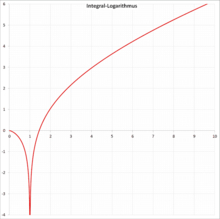Funktionsgraph von
li
(
x
)
{\displaystyle \operatorname {li} (x)}
Der Integrallogarithmus ist eine analytische Funktion auf den reellen Zahlen
x
≥
0
,
x
≠
1
{\displaystyle x\geq 0,\;x\neq 1}
x
>
1
{\displaystyle x>1}
Quantenfeldtheorie und bei der Lösung der Laplace-Gleichung in Halbleitern sowie in der Zahlentheorie , da sie eng mit der Dichte der Primzahlen verknüpft ist.
Definition
Es sind zwei Definitionen üblich, die sich um eine Konstante unterscheiden. Für eine der wichtigsten Anwendungen – als asymptotische Vergleichsgröße für die Primzahlfunktion im Primzahlsatz – spielt der Unterschied zwischen den beiden Definitionen keine Rolle.
Eine Definition im Bereich
x
≥
0
{\displaystyle x\geq 0}
li
(
x
)
=
∫
0
x
d
t
ln
t
,
{\displaystyle \operatorname {li} (x)=\int _{0}^{x}{\frac {\mathrm {d} t}{\ln t}\ ,}
dabei muss
li
{\displaystyle \operatorname {li} }
Singularität bei
x
=
1
{\displaystyle x=1}
x
>
1
{\displaystyle x>1}
Grenzwert definiert werden (cauchyscher Hauptwert ):
li
(
x
)
=
lim
ε
→
0
+
(
∫
0
1
−
ε
d
t
ln
t
+
∫
1
+
ε
x
d
t
ln
t
)
.
{\displaystyle \operatorname {li} (x)=\lim _{\varepsilon \to 0^{+}\left(\int _{0}^{1-\varepsilon }{\frac {\mathrm {d} t}{\ln t}+\int _{1+\varepsilon }^{x}{\frac {\mathrm {d} t}{\ln t}\right)\ .}
Eine andere Definition für
x
>
1
{\displaystyle x>1}
Li
(
x
)
=
li
(
x
)
−
li
(
2
)
=
∫
2
x
d
t
ln
t
.
{\displaystyle \operatorname {Li} (x)=\operatorname {li} (x)-\operatorname {li} (2)=\int _{2}^{x}{\frac {\mathrm {d} t}{\ln t}\ .}
Dabei liegt bei
x
=
1
{\displaystyle x=1}
Verzweigungspunkt vor.
Eigenschaften
Funktionsgraph von
li
(
x
)
{\displaystyle \operatorname {li} (x)}
Einige Werte:
li
(
0
)
=
0
{\displaystyle \operatorname {li} (0)=0}
li
(
1
)
=
−
∞
{\displaystyle \operatorname {li} (1)=-\infty }
li
(
μ
)
=
0
{\displaystyle \operatorname {li} (\mu )=0}
li
(
2
)
=
1,045
16
37801
17492
78484
…
{\displaystyle \operatorname {li} (2)=1{,}04516\;37801\;17492\;78484\ldots }
A069284 in OEIS )Dabei ist
μ
=
1,451
36
92348
83381
05028
…
{\displaystyle \mu =1{,}45136\;92348\;83381\;05028\ldots }
A070769 in OEIS ) die Ramanujan-Soldner-Konstante .
Es gilt
li
(
x
)
=
Ei
(
ln
x
)
{\displaystyle \operatorname {li} (x)=\operatorname {Ei} (\ln x)}
Integralexponentialfunktion
Ei
{\displaystyle \operatorname {Ei} }
li
(
x
)
=
γ
+
ln
|
ln
x
|
+
∑
k
=
1
∞
(
ln
x
)
k
k
⋅
k
!
,
{\displaystyle \operatorname {li} (x)=\gamma +\ln \left|\ln x\right|+\sum _{k=1}^{\infty }{\frac {(\ln x)^{k}{k\cdot k!}\ ,}
wobei
γ
=
0,577
21
56649
01532
86060
…
{\displaystyle \gamma =0{,}57721\;56649\;01532\;86060\ldots }
A001620 in OEIS ) die Euler-Mascheroni-Konstante ist.
Aus der Definition von
li
{\displaystyle \operatorname {li} }
lineare Substitution
li
(
x
)
=
x
∫
0
1
d
t
ln
(
x
t
)
,
{\displaystyle \operatorname {li} (x)=x\int _{0}^{1}{\frac {\mathrm {d} t}{\ln(x\,t)}\ ,}
wobei für
x
>
1
{\displaystyle x>1}
t
=
1
/
x
{\displaystyle t=1/x}
x
≥
0
,
x
≠
1
{\displaystyle x\geq 0,x\neq 1}
∫
0
x
li
(
t
)
d
t
=
x
li
(
x
)
−
li
(
x
2
)
.
{\displaystyle \int _{0}^{x}\operatorname {li} (t)\,{\mathrm {d} t}=x\,\operatorname {li} (x)-\operatorname {li} (x^{2}).}
Außerdem gilt für
p
>
−
1
,
p
≠
0
{\displaystyle p>-1,p\not =0}
∫
0
1
li
(
t
)
t
p
−
1
d
t
=
−
1
p
ln
(
p
+
1
)
,
{\displaystyle \int _{0}^{1}\operatorname {li} (t)\,t^{p-1}\,\mathrm {d} t=-{\tfrac {1}{p}\ln(p+1),}
für
p
=
1
{\displaystyle p=1}
∫
0
1
li
(
t
)
d
t
=
−
ln
2.
{\displaystyle \textstyle \int _{0}^{1}\operatorname {li} (t)\,\mathrm {d} t=-\ln 2.}
p
=
0
{\displaystyle p=0}
∫
0
1
li
(
t
)
t
−
1
d
t
=
−
1.
{\displaystyle \textstyle \int _{0}^{1}\operatorname {li} (t)\,t^{-1}\,\mathrm {d} t=-1.}
Eine weitere Formel ist
∫
0
1
li
(
t
−
1
)
t
d
t
=
∫
1
∞
li
(
t
)
t
−
3
d
t
=
0.
{\displaystyle \textstyle \int _{0}^{1}\operatorname {li} (t^{-1})\,t\,\mathrm {d} t=\textstyle \int _{1}^{\infty }\operatorname {li} (t)\,t^{-3}\,\mathrm {d} t=0.}
Die Golomb-Dickman-Konstante
λ
=
∫
0
1
e
li
(
x
)
d
x
=
0,624
32
99885
43550
87099
…
{\displaystyle \lambda =\textstyle \int _{0}^{1}\mathrm {e} ^{\operatorname {li} (x)}\mathrm {d} x=0{,}62432\;99885\;43550\;87099\ldots }
A084945 in OEIS ) tritt in der Theorie zufälliger Permutationen bei der Abschätzung der Länge des längsten Zykels einer Permutation und in der Zahlentheorie bei der Abschätzung der Größe des größten Primfaktors einer Zahl auf.
Asymptotisches Verhalten
Funktionsgraph von
li
(
x
)
{\displaystyle \operatorname {li} (x)}
13 Für große
x
{\displaystyle x}
li
(
x
)
{\displaystyle \operatorname {li} (x)}
li
(
x
)
=
0
!
x
ln
x
+
1
!
x
ln
2
x
+
2
!
x
ln
3
x
+
3
!
x
ln
4
x
+
⋯
{\displaystyle \operatorname {li} (x)=0!\,{\frac {x}{\ln x}+1!\,{\frac {x}{\ln ^{2}x}+2!\,{\frac {x}{\ln ^{3}x}+3!\,{\frac {x}{\ln ^{4}x}+\dotsb }
approximieren . Die Reihe ist eine asymptotische Entwicklung ; sie konvergiert nicht, sondern nähert sich dem wahren Wert an, um sich dann wieder zu entfernen.
Die beste Approximation wird nach etwa
ln
x
{\displaystyle \ln x}
Fakultät .
Siehe auch
Literatur
Weblinks



































